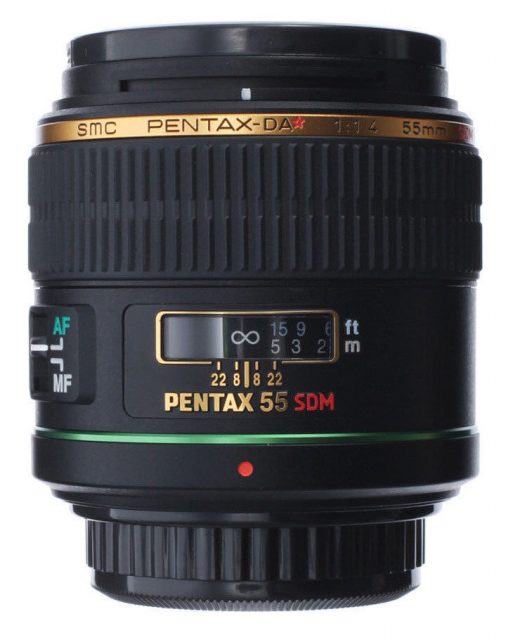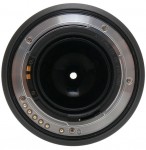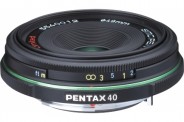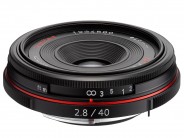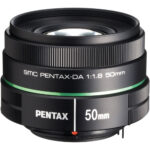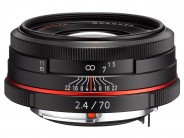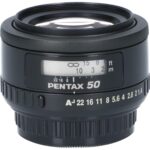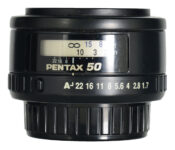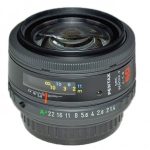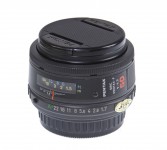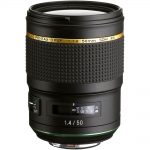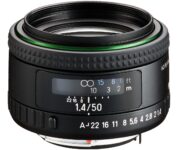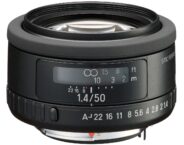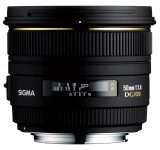Announced
Production status
Original name
System
Class
Pros and cons
Downloads
Genres or subjects of photography
Recommended slowest shutter speed when shooting static subjects handheld
smc Pentax-DA* 55mm F/1.4 SDM
Short telephoto prime lens • Digital era
Abbreviations
| SMC | Multi-layer anti-reflection coating is applied to the surfaces of lens elements. This anti-reflection coating increases light transmission, eliminates flare and ghosting, and maintains color consistence among all lens models. |
| * | Professional lens with high quality optics and robust build. Meets the highest standards and provides excellent performance and flawless image quality unachievable with traditional optical technologies. |
| DA | Autofocus lens optimized for Pentax digital SLR cameras. Learn more |
| SDM | The lens is equipped with Supersonic Drive Motor. |
Specification





| Optical design: | |
| 55mm | |
| F/1.4 | |
| APS-C | |
| Pentax K [45.5mm] | |
| 28.8° (Pentax K APS-C) | |
| 9 elements in 8 groups | |
| 1 ED | |
| Floating element system | |
| 35mm equivalent focal length and speed: | |
35mm equivalent focal length: | 84.2mm (in terms of field of view) |
35mm equivalent speed: | F/2.1 (in terms of depth of field) |
| Diaphragm mechanism: | |
Diaphragm type: | Automatic |
Aperture control: | None; the aperture is controlled from the camera |
| 9 (nine) | |
| Focusing: | |
| 0.45m | |
| 1:5.88 | |
Focusing modes: | Autofocus, manual focus |
Autofocus motor: | Supersonic Drive Motor |
Manual focus control: | Focusing ring |
Focus mode selector: | AF - MF |
Quick-Shift Focus System (QFS): | Yes |
| Shake Reduction (SR): | |
| - | |
| Physical characteristics: | |
| 375g | |
| ⌀70.5×66mm | |
| Dust-proof and water-resistant barrel | |
| Yes | |
| Accessories: | |
| Screw-type 58mm | |
| PH-RBH58 - Bayonet-type round, with filter access window | |
| HD Pentax-DA 1.4X AF Rear Converter AW → 77mm F/2 |
Sources of data
- Manufacturer's technical data.
- smc Pentax-DA interchangeable lenses operating manual (May 2009).
Manufacturer description #1
September 22, 2008 - HOYA CORPORATION PENTAX Products is pleased to announce the launch of two high-performance interchangeable lenses for the acclaimed smc PENTAX-DA (DA Star) series. These lenses are designed exclusively for use with PENTAX digital SLR cameras to deliver top-quality digital images. The smc PENTAX-DA60-250mmF4ED[IF] SDM is a versatile telephoto zoom lens offering a high zoom ratio, while the smc PENTAX-DA55mmF1.4 SDM is a compact medium-telephoto lens offering a large maximum aperture.
[Common Features of Two New Lenses]
1. High image quality
The two lenses are the newest members of the exclusive DA Star series, developed as part of PENTAX’s pursuit of the highest image quality, and are designed to deliver the top optical performance of all PENTAX interchangeable lenses. Combining a host of advanced technologies including super-low-dispersion optical elements, extra-low dispersion (ED) optical elements and PENTAX-original lens coatings, they assure outstanding image description with clear, high-contrast images, even at edges of the image field.
2. Dust/water-resistant construction
Featuring a set of special seals, the lenses feature a reliable dust-resistant, water-resistant construction to prevent intrusion of dust, water and moisture into the lens body.
3. Quick-Shift Focus system
The PENTAX-invented Quick-Shift Focus system allows instant switching to manual-focus operation, after the subject is captured in focus by the camera’s autofocus system.
4. SP coating to block dust and stains
The front surface of the optics is treated with the PENTAX-original Super Protect (SP) coating. Applying a special fluorine compound to the lens surface through a vapor deposition process, this coating effectively repels dust, water and grease, making it easy to wipe off annoying stains such as fingerprints and cosmetic marks.
5. Digital SLR-exclusive optical design
Thanks to a combination of special lens coatings, ideal curvature and best positioning of optical elements, these lenses are designed to optimize digital imaging characteristics, while effectively minimizing flare and ghost images. Their image circle is perfectly proportioned to the image-sensor size of PENTAX digital SLR cameras. Despite their large maximum aperture, they are designed to be compact and lightweight to enhance maneuverability and operability.
[Main Features of the smc PENTAX-DA60-250mmF4ED[IF] SDM Lens]
- When mounted on a PENTAX digital SLR camera body, this zoom lens provides focal lengths from 92mm to 383mm in the 35mm format. Its 4.2-times zoom ratio covers a broad telephoto range, making it ideal for capturing various sports scenes and portraits.
- Two extra-low dispersion (ED) optical elements are incorporated into the optics for minimal chromatic aberrations. A unique nonlinear shifting system employed in the zoom mechanism effectively reduces field curvature aberrations and assures solid image-description performance at all focal lengths.
- The large F4 maximum aperture is retained over the entire zoom range to assure a faster shutter speed or reduce the depth of field.
- An innovative hybrid AF system offers both extra-smooth, super-quiet SDM autofocus operation using a supersonic motor installed in the lens body and conventional autofocus operation using a motor built into the camera body.
[Main Features of smc PENTAX-DA55mmF1.4 SDM Lens]
- When mounted on a PENTAX digital SLR camera body, this medium-telephoto lens offers a focal length of 84.5mm in the 35mm format. Coupled with its large F1.4 maximum aperture, it is ideal for portraiture applications.
- A newly developed Aero Bright Coating enhances image-description performance by effectively reducing reflections over a wider wavelength range. Compared to conventional multi-coatings, this new coating greatly improves light transmittance in the lens, while drastically reducing flare and ghost images that deteriorate image quality.
- A combination of the latest optical design and a round-shaped diaphragm assures soft, beautifully obscured out-of-focus description, maximizing the advantage of a large-aperture lens in shallow depth-of-field applications.
- Super-low-dispersion optical element is incorporated into the optics for effective compensation of a variety of aberrations.
- The advanced SDM mechanism assures extra-smooth, super-quiet autofocus operation using a supersonic motor installed in the lens body. Thanks to its SDM-exclusive autofocus system, the lens is designed to be quite compact, despite its large maximum aperture.
Manufacturer description #2
This medium telephoto lens is ideal for portraits and versatile for all shooting conditions. Its large aperture F1.8 combined with its round diaphragm produce natural, beautiful bokeh (out-of-focus effect). In addition, it has the new coating (Aero Bright Coating) allowing greater light transmittance and better filtering of flare. Its ultrasonic technology (Super Directdrive Motor) ensures speed and quiet operation focus. Protection against humidity and dust makes it a reliable lens for outdoor use.
Manufacturer description #3
Featuring both sharpness and natural out-of-focus (bokeh) effect. Large aperture Star series lens ideal for portraits. This lens features high resolution for sharp, crystal-clear images of subjects and a smoothly connected out-of-focus (bokeh) softness. This is a medium telephoto lens that is ideal for portraits. The lens uses Anomalous Dispersion Glass for reducing color blurring and enabling images with high contrast and sharpness. It also uses the "Aero Bright Coating," which features higher transmissivity than conventional coatings for delivering high image quality with unparalleled sharpness and a minimum of flare. The lens uses a round iris diaphragm for providing natural out-of-focus (bokeh) effect and has a dust-resistant and drip-proof construction. The AF system is for SDM (AF using internal lens ultrasonic motor) only.
This is a medium telephoto single focal point lens equivalent to 84.5mm in the 35mm film format, and it includes a large aperture with an extremely bright open F value of 1.4. This lens is ideal for portrait and other photography.
The newly developed Aero Bright Coating provides exceptional reflection performance over a wide wavelength range. This enables a significantly higher transmissivity for a substantial reduction in flare and ghosting, which adversely affect imaging performance.
The newest optical design and a round iris diaphragm (up to F2.8) were developed with special attention to providing a natural, soft out-of-focus (bokeh) effect with a shallow depth of field that is only possible with large aperture lenses.
The various lens components have been sealed for enabling a dust-resistant and drip-proof construction that prevents the entry of water and dust into the lens.
If you turn the focus ring after focusing by the AF, focusing instantly switches to the manual focus. This enables smooth focusing operations without the need for a switching operation.
A special coating is used on the front lens for repelling water and oils. This enables any water and oils on the lens to be easily removed for effective protection of the lens surface.
This design has been optimized for digital image characteristics to minimize ghosting and flare. Also, the image circle is tailored specifically to the size of the imaging elements for allowing a compact, lightweight body size for a large aperture lens.
Pentax-DA series
The fourth generation of autofocus lenses designed for Pentax APS-C digital SLR cameras. Introduced with the Pentax *ist D in 2003.
- Lens barrels made from engineering plastic;
- Do not have an aperture ring. The aperture is controlled from the camera;
- Automatic focusing using in-camera or in-lens motor;
- Quick-Shift Focus System (except for DA L models).
Travellers' choice
- Ultra fast speed (F/1.4)
- Lightweight (375g)
- Dust-proof and water-resistant barrel
- Super Protect (SP) coating
From the editor
The lens uses linear extension method for focusing however the front element does not extend beyond the lens barrel during focusing.
The front element is deeply recessed inside the lens barrel which eliminates the need for a lens hood.
Unfortunately, the window cap cannot be attached or removed when the hood is mounted on the lens.
Compared to other short telephoto prime lenses in the Pentax K APS-C system
- Fastest speed (F/1.4)
- Largest magnification (1:5.88)
- Heaviest weight (375g)
- Longest length (66mm)
- Not a pancake lens, along with the smc Pentax-DA 50/1.8
- Weather sealed
- Largest filter size (58mm)
